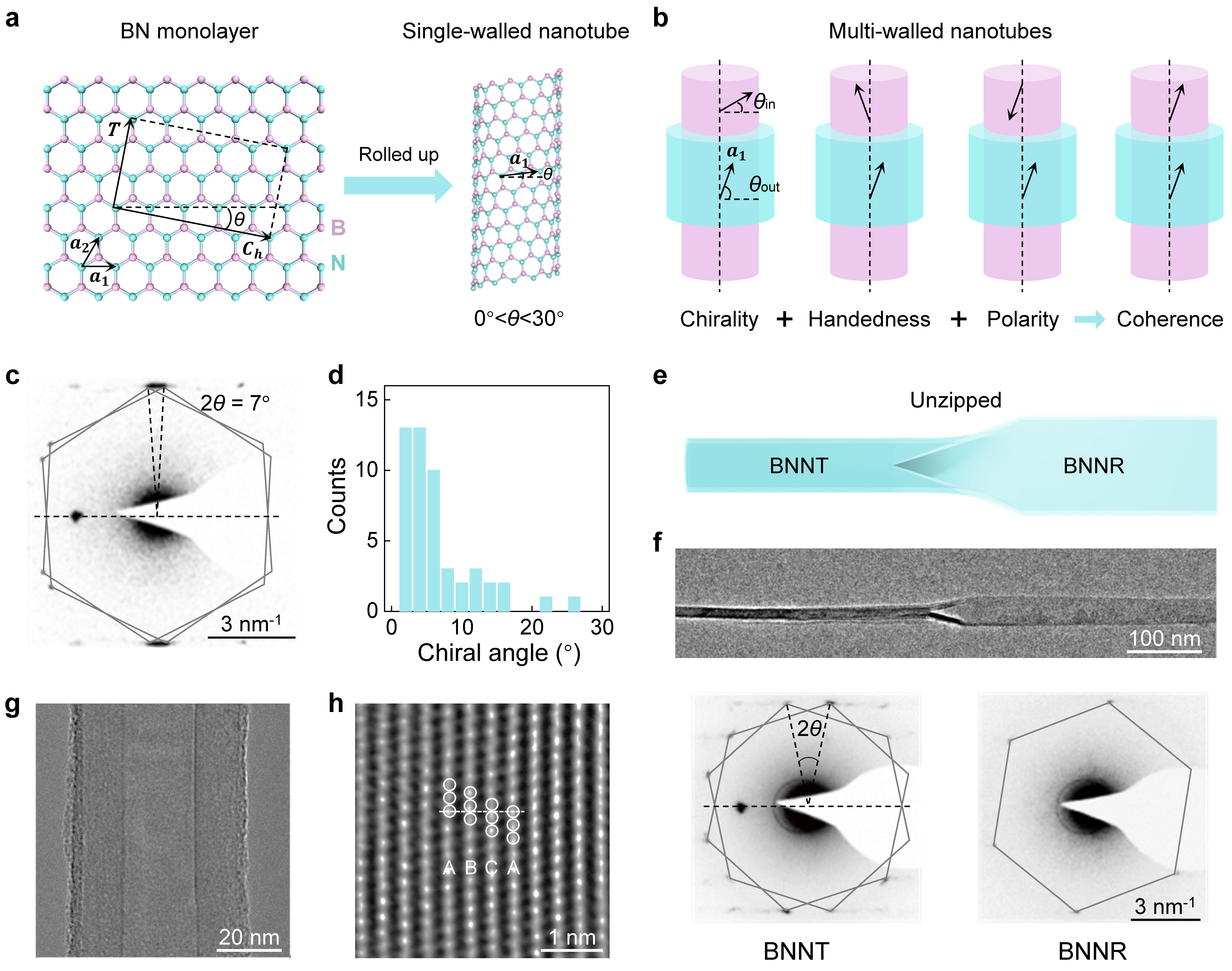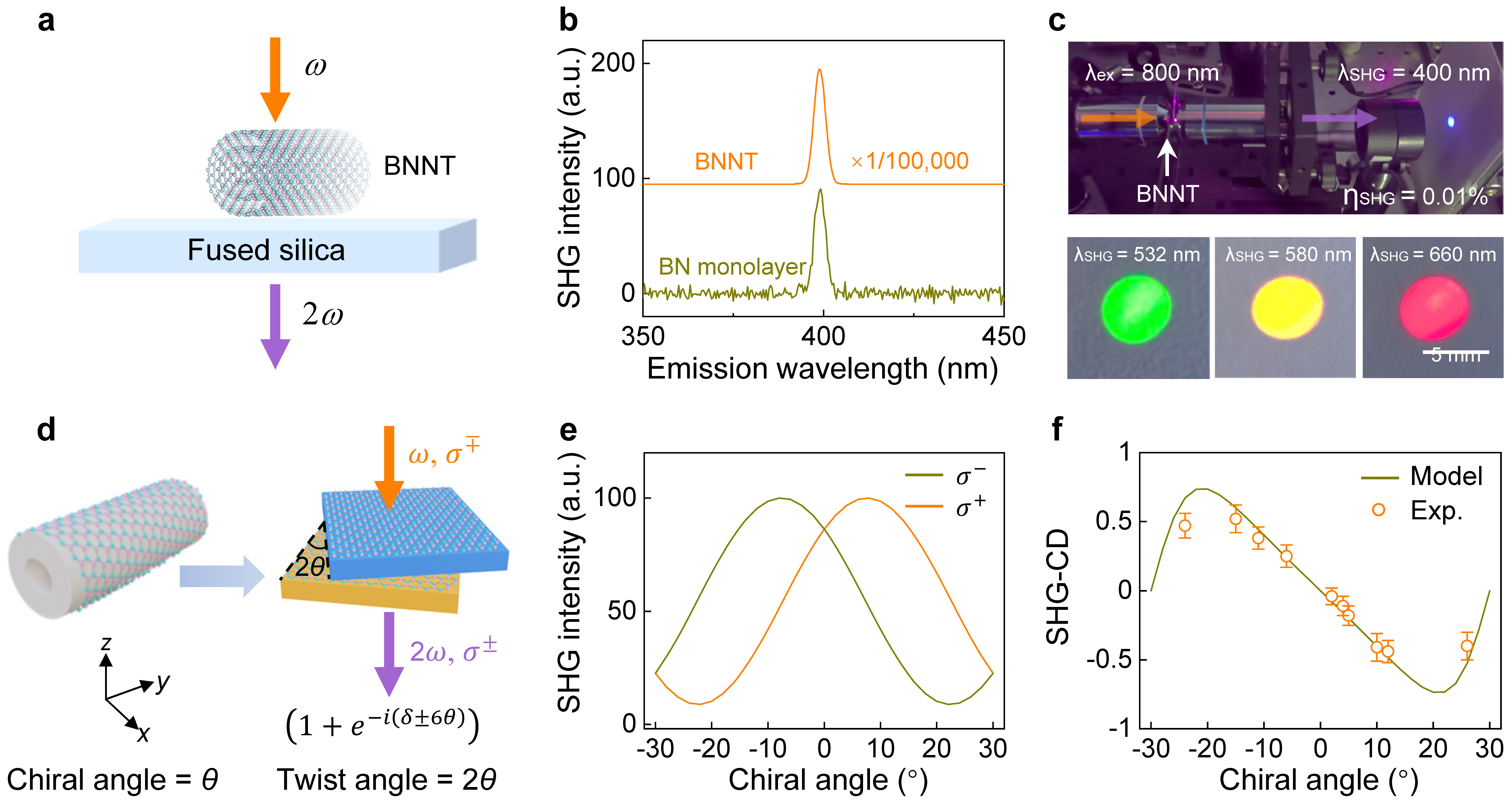The discovery of a coherent stacking configuration and strong chiroptical nonlinearity in multi-walled boron nitride nanotubes
Published in Physics

When two-dimensional (2D) layered materials are rolled up along a defined direction, the formed one-dimensional (1D) nanotubes naturally possess intrinsic chirality and highly stable architectures (Fig. 1a), showcasing a wealth of physical phenomena and enabling innovative applications. However, an individual multi-walled nanotube is generally composed of the coaxial single-walled nanotubes with diverse chiral geometry, including chirality, handedness and polarity (Fig. 1b). This complex intertube stacking configurations diminish the remarkable physical properties arising from the polar structure of their component nanotubes and thus limits the exploration of their unique applications. Occasionally, we observed exceptionally large second-harmonic generation (SHG) responses in as-grown boron nitride nanotubes (BNNTs). This suggests that the stacking order of the component tubes within an individual BNNT should exhibit a high degree of correlation. What’s more, the intrinsic chiral geometry motivates us to explore the potentials of BNNTs as a kind of chiral nonlinear optical crystals, which have the capacity to control the light polarization in the nonlinear process.
Nowadays, the manipulation of nonlinear parametric light is highly desirable for various advanced applications in both classical and quantum nonlinear optics, such as optical encryption and security, nonlinear holographic imaging and quantum information process. However, there is a trade-off between the high nonlinear susceptibility for efficient SHG output and strong chirality for a large nonlinear chiroptical response (known as SHG circular dichroism, SHG-CD) in all conventional materials. This trade-off phenomenon primarily arises from the fact that a nonlinear optical crystal usually tends to suppress the chiral effect due to the spatial translational symmetry (except for some special crystals with weak chirality, such as quartz) and an isotropic collection of chiral molecules with high optical activity forbids a strong SHG response. Thus, exploring intrinsic chiral materials with high stability, strong optical nonlinearity and large chiroptical response is still highly demanded.
Here, in the work just published in Nature Nanotechnology, we demonstrate that the as-grown multi-walled boron nitride nanotubes (BNNTs) features the coherent stacking structures including the nearly mono-chirality, homo-handedness and uni-polarity among the component tubes. This configuration enables strong chiroptical nonlinearity of BNNTs with a giant SHG yield (0.01% conversion efficiency and microwatt output, record values among all known 1D materials) as well as an intrinsic and continuously tuneable SHG-CD (from -0.7 to +0.7).
In our experiments, the multi-walled BNNTs were grown via the catalytic chemical vapour deposition (CVD) method. We examined numerous high-quality nanotubes and found that they primarily exhibited single chiral angles, where the diffraction pattern of a multi-walled BNNT showed two sets of hexagonal spots (Fig. 1c,d). To characterize the handedness of each component, we unzipped the multi-walled BNNTs by using a plasma etching method to yield BN nanoribbons (BNNRs, Fig. 1e). The two sets pattern in BNNT degenerate to one set in the unzipping BNNR area (Fig. 1f), directly validating the homo-handedness of each component for the multi-walled nanotube. Furthermore, we performed high-resolution TEM (HRTEM) imaging to characterize the stacking structure of a BNNT (Fig. 1g). The magnified HRTEM image indicated that the walls of the BNNT had the ABC stacking order (Fig. 1h), which resembled the rhombohedral BN crystal. Thus, different coaxial walls in the BNNT are expected to have a parallel interlayer stacking order with uni-polarity.

Fig. 1︱Structure of coherently stacked BNNTs. a, Schematic of a BN monolayer rolled up as a single-walled BNNT. The chiral angle can be regarded as an angle between vector and its radial direction. b, Intertube stacking configuration in multi-walled BNNTs depending on the chirality, handedness and polarity of each component. Coherence stacking implies uniform chirality, handedness and polarity. c, TEM diffraction image of a multi-walled BNNT, indicating the nearly mono-chirality with a chiral angle of ~3.5°. d, Histogram of the chirality distribution for 50 BNNTs. e, Schematic view of a BNNT along a segment unzipped into a BNNR. f, TEM image (top) and diffraction images (bottom) of a BNNT after plasma etching to form the multi-layer BNNR. Two sets of patterns degenerate to one set after unzipping, indicating the homo-handedness of the BNNT. g,h, HRTEM image (g) and its partially enlarged image (h) of BNNT. The ABC stacking order in indicates the uni-polarity between walls in BNNT.
The polar structures of the BNNTs imply the absence of inversion symmetry and the presence of SHG responses. We performed SHG measurements in the transmission geometry with BNNTs monodispersed on a fused silica substrate (Fig. 2a). The coherent-stacking configuration will bring a giant SHG enhancement with increasing the number of coaxial walls of BNNTs, because of the constructive interference between walls. Under 800 nm femtosecond pulse excitation, an individual BNNT with an outer diameter of ~350 nm exhibited a strong SHG response with a spectral peak at 400 nm, where the SHG intensity was ~100,000 times stronger than that of the BN monolayer (Fig. 2b). We observed an individual BNNT with a giant SHG yield, where the conversion efficiency was up to 0.01% and SHG output was visible to the naked eye at the microwatt level in the ultraviolet to visible range (Fig. 2c). We also investigated the chiroptical SHG response in BNNTs, where a simplified physical model was established to qualitatively understand this nonlinear optical process. According to this model, the difference of SH electric field under different circularly polarized light excitation can be directly analysed. Furthermore, to quantitatively describe the chiroptical SHG response in BNNTs, the effects of intrinsic curvature and nanocavity formed by the nanotubes should be carefully considered. We conducted simulations to explore the SHG responses of BNNTs with continuously varying chiral geometries, where the SHG intensities and corresponding SHG-CD values evolved with the chiral angles (Figs. 2e,f). The absolute value of the maximum SHG-CD reached 0.73. Experimentally, we measured the SHG-CD values for several BNNT samples on TEM grids (chiral angles determined by TEM) and found good agreement with the simulation (Fig. 2f).

Fig. 2︱Strong chiroptical nonlinearity in BNNT. a, Side-view illustration of a multi-walled BNNT and its SHG response. b, SHG spectra of a BNNT and BN monolayer. Under 800 nm pulsed laser excitation, the SHG signal of the BNNT is five orders of magnitude stronger than that of the BN monolayer. c, Panchromatic SHG response of the BNNT under nonresonant excitation. The generated light at wavelengths of 400 nm, 532 nm, 580 nm and 660 nm is recorded using a camera. d, Schematic of a BNNT with a chiral angle θ (left panel) regarded as twisted rBN flakes with twist angle 2θ (right panel). The blue and yellow flakes correspond to the upper and lower walls of the BNNT. e, Simulated chiral SHG intensity of BNNTs with different chiral angles. The chiral structures show a significant difference in the SHG response under the two circularly polarized light excitations. f, Calculated (solid line) and experimental (dots) SHG-CD of BNNTs with different chiral angles. The SHG-CD values are highly correlated with chiral angles. Experiment data are presented as mean values ± standard deviation of SHG-CD for each sample from five measurements, where open circles are the mean values and error bars indicate ± standard deviation.
The observation of BNNTs with coherently stacked structures suggests the potential for exploring stacking configurations in 1D nanotubes, which could give rise to fascinating phenomena such as sliding ferroelectricity, chiral shift currents, nonreciprocal superconductivity and bulk photovoltaic effects. The unique optical properties and high stability of BNNTs, as well as their good integrability with silicon-based devices, should offer exciting opportunities in the design of optoelectronic and nanophotonic devices. Our next aim is to hybridize the BNNTs with a nanocavity or metasurface for the realization of on-chip light sources and modulators.
For more information, please read our recent publication in Nature Nanotechnology (https://doi.org/10.1038/s41565-024-01685-3)
Follow the Topic
-
Nature Nanotechnology

An interdisciplinary journal that publishes papers of the highest quality and significance in all areas of nanoscience and nanotechnology.
Your space to connect: The Polarised light Hub
A new Communities’ space to connect, collaborate, and explore research on Light-Matter Interaction, Optics and Photonics, Quantum Imaging and Sensing, Microscopy, and Spectroscopy!
Continue reading announcement

Please sign in or register for FREE
If you are a registered user on Research Communities by Springer Nature, please sign in